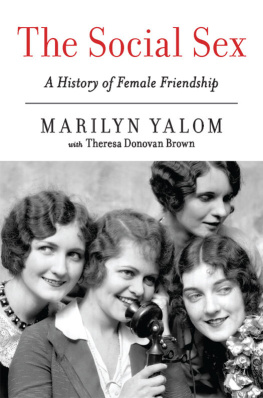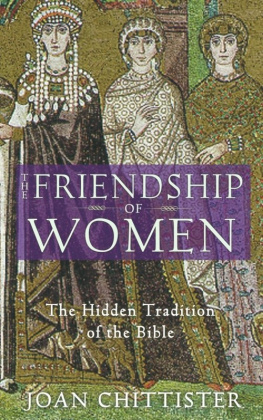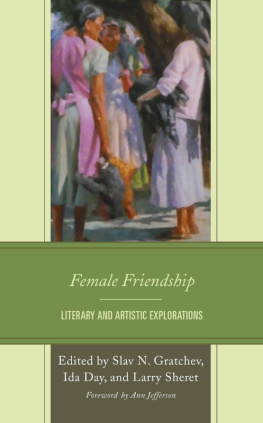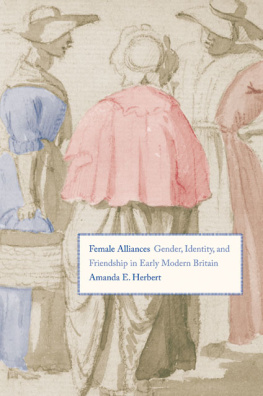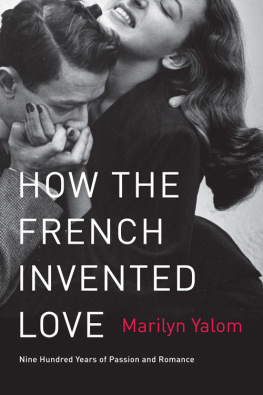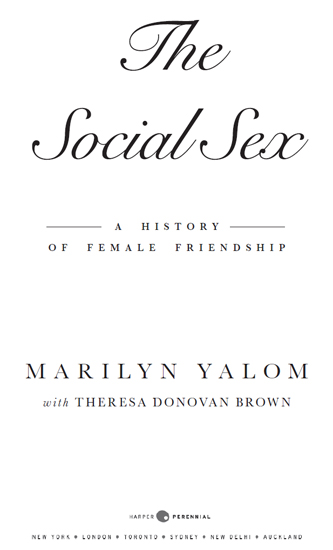
For Irv and Paul
CONTENTS
Guide
T HIS BOOK OWES ITS INCEPTION to the loss of a beloved woman, Diane Middlebrook. When Diane died in December 2007, I lost a friend who had been my colleague, confidante, and sister author for more than three decades. In the months following her death, I painfully realized just how precious and irreplaceable her friendship had been. Others who knew Diane shared this bittersweet perception. Having watched Dianes determined fight against the tumor that eventually devoured her, having seen her find sustenance in writing until the very end, I could think of no better way to honor her memory than to craft a book about female friendship.
We Americans take for granted the ability of women to choose their friends and spend time with them as they wish. We blithely assume that this is the natural state of affairs. Yet in many parts of the world today, girls and women must ask for permission from their fathers, mothers, husbands, brothers, or older sisters to meet with their friendsthat is, if they are allowed to have them at all. Even in America, friendships are often subject to parental or spousal control. Parents certainly try to direct their children toward other children whom they consider suitable, and marriage often means that the new wife has less time for her single friends. Even in America, a womans freedom to choose and spend time with her friends is circumscribed by familial, economic, and cultural considerations.
The subject of friendship is less glamorous than the subject of love, which still commands center stage in life and literature, not to mention the publishing world. I, too, have been guilty of contributing to the plethora of books focusing on love (e.g., How the French Invented Love) without considering its near relative. During the many months of our collaboration, Theresa Donovan Brown and I have explored the overlap between love and friendship and have often found that it is difficult for us to make clear-cut distinctions. What is friendship? Is it so different from love?
Theresa and I, friends as well as collaborators, are keenly aware that we are writing from a specific place and from a specific moment in time. What we have to say about women as friends is undoubtedly colored by our own situations, yet we hope to cast our net beyond our narrow enclave in Northern California and encompass the experiences of many other women elsewhere. Friendship is the birthright of all American women today, and, for many of them, the crown jewel of personal life. Looking back through history, it is remarkable and edifying to see how friendship evolved as a real option for women. Precious and important as these bonds are for anyone who cares about or relies upon women, a history of female friendships cautions us against taking them for granted.
Marilyn Yalom
D O MEN OR WOMEN HAVE more friends? The answer today in the United States is most likely to be women. Popular wisdom tells us that women are basically more sociable, more open, more empathetic, more nurturing, more collaborative, more friendly than men. The media reinforce this stereotype with films, TV shows, and chick lit novels that depict the close bonds many girls and women enjoy throughout their lives. Moreover, some scholarly studies have contended that women develop deeper, more intimate friendships than men, and that womens friendships are vital both to their mental health and, in evolutionary terms, to the survival of their offspring. Good friendswhether women or menare now considered indispensable to the well-being of American women, whatever their age.
The difference between male and female friendship patterns has been a pop-culture and academic hot topic for at least twenty-five years. Many women confide in their friends, while many men simply enjoy hanging out together. All too often, competitiveness colors male relationships and prevents men from disclosing their frailties and pain to their friends. Hence mens intimate discussions are often reserved for their girlfriends, spouses, or platonic women friends. This allows many men to project a public persona that is independent and self-sufficientmasculine qualities par excellence.
On the other hand, a woman without close friends, however successful she may be, is often judged to be lacking the emotional capital long associated with the female sex. Adolescent girls and college-age women are often thought to rely heavily on their friends for empathy and feedback. While young women may pull back from time-consuming friendships in the initial stages of a marriage, they seem to find friends again as the need arises: they seek out female colleagues and mentors as they negotiate the demands of the workplace, they communicate with other mothers as they raise their children, they exchange worrisome secrets as they undergo menopause or divorce, and they lean on one another as they suffer through cancer, other illnesses, or the death of a spouse. How many times have we heard a woman say: I would never have made it without my friends.
This prominence of women as friends would have surprised people living in the distant past. Almost all the documents on friendship during the first two thousand years of Western historyfrom 600 BCE to 1600 CEpertain to men. Of course, almost all these documents were written by men, for other men. But the focus on mens friendships is more than a question of gendered authorship and readership. Male authors extolled friendship as a male enterprise, necessary not only for personal happiness but also for civic and military solidarity. When an ancient Greek philosopher invoked friendship as the noblest form of human attachment, he did not consider women worthy of attention since they were noncitizens, nonsoldiers, and nonparticipants in the public realm. Sequestered in the domestic sphere of Greek homes, women might have had friends among themselves, but what did that contribute to the greater good?
Moreover, women were notoriously weaker than men and were considered constitutionally unsuited for friendship at the highest level, according to a negative view of female friendship that persisted long after the Greeks and Romans. Their rivalries, jealousies, and lack of steadfast loyalty would be thrown in womens faces for centuries to come. Indeed, as late as the midnineteenth century, the British Saturday Review posed the question of whether women were even capable of friendships within their own sex. Even today, films and TV shows emphasize the mean-spirited cliques of catty teenagers and the sexual rivalries of young women, following a tradition of stereotypes that has long undermined the value of women as friends.
The evidence for friendship among Greek and Roman men of the citizen class, among medieval clerics and crusaders, and among Renaissance humanists is substantial. Though separated by space, time, language, and culture, they wrote extensively about the virtues of male friendship in a variety of genres, including letters, treatises, memoirs, and stories. For example, the rousing French epic The Song of Roland (circa 1100) features the heroic friendship of Roland and Olivier on the battlefield, following a literary tradition that goes back two millennia to the characters of Achilles and Patroclus in Homers Iliad, and even earlier, to the Babylonian story of Gilgamesh and Enkidu. In contrast, female friendship was not a theme in classical or medieval literature except in rare cases that usually revolved around a heterosexual love affair, with one woman playing the role of confidante to another.
Elsewhere during the Middle Ages, in the quiet confines of Christian monasteries, intimate friendships sprang up among the monks who lived, worked, and prayed together. Venerable leaders and future saints such as Anselm of Canterbury (1033-1109) and Bernard of Clairvaux (1090-1153) wrote numerous letters that expressed deep affection for other men of the cloth, regardless of whether they were superiors in rank, like abbots, priors, or bishops, or simply fellow monks. But by the time of Anselms death in 1109, comparable letters were being written by women living in nunneries. Those of Hildegard of Bingen (10981179), no less crafted in Latin than those of Saint Anselm, testify to the close friendships women experienced in convents. Hildegards forceful personality shines through the many epistles she sent to several women she knew and loved. Today her correspondence, like that of Saint Anselm, comprises three volumes. But despite the numerous women friends who received and answered her letters, the public face of friendship remained resolutely male.
Next page
